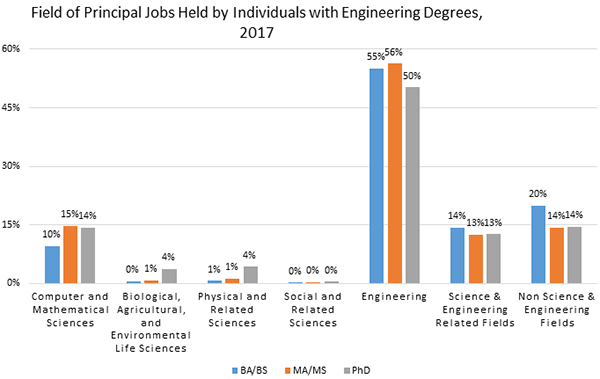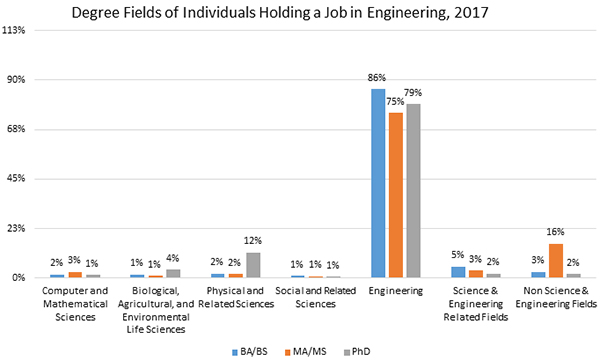A SNAPSHOT OF ENGINEERING DEGREE-HOLDERS IN THE U.S. WORKFORCE
By Carolyn Wilson
Reprinted from ASEE Connections
The National Science Foundation conducts a biennial survey of the college educated workshop with a focus on the science and engineering workforce, called the National Survey of College Graduates1. Using the 2017 dataset of the National Survey of College Graduates, this Databyte compares the terminal degree and degree field for the engineering workforce with the workforce opportunities for those with a terminal degree in engineering.
Among those individuals with a bachelor’s, Master’s, or Doctoral terminal degree in engineering, the majority currently work within the engineering workforce. Approximately 55% of bachelor’s graduates, 56% of Master’s graduates, and 50% of doctoral graduates in engineering currently work as engineers (Figure 1). However, this also means that 45% of engineering bachelor’s graduates, 44% of engineering Master’s graduates, and 50% of engineering doctoral graduates work in other areas of the workforce. Many of those individuals are working within the computer and mathematical sciences, science- and engineering-related fields, and fields outside of science and engineering. This distribution of trained engineers across various other fields and areas within the U.S. workforce highlights the transferability of skills gained by engineering graduates at all degree levels. Many occupations are interested in hiring new employees with critical thinking skills, problem solving skills, analytical skills, and computer technology skills. All of these skillsets are well-represented within the engineering higher education curriculum, creating more opportunities for engineering graduates as they enter the workforce.
Overwhelmingly, the engineering workforce itself is filled with individuals who hold a terminal degree in an engineering field. Within the engineering workforce, approximately 86% of bachelor’s graduates, 75% of Master’s graduates, and 79% of doctoral graduates hold a terminal engineering degree (Figure 2). While engineering degree-holders can work effectively within other areas in the workforce, trained engineers are necessary for the engineering workforce. Within the engineering workforce, less than 6% of employees, overall, hold degrees from other fields. Non-engineers are better represented at the master’s level (16%—mostly MBAs) and at the doctoral level, where 12% of employees hold degrees in physical and related sciences.
1NSF’s National Survey of College Graduates. https://www.nsf.gov/statistics/srvygrads/


